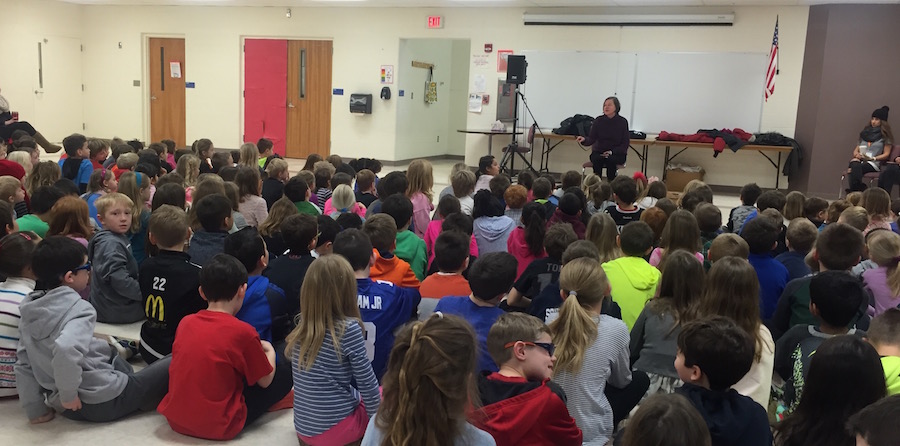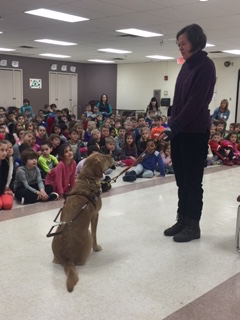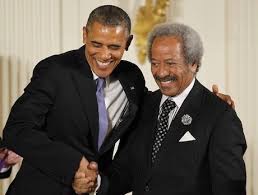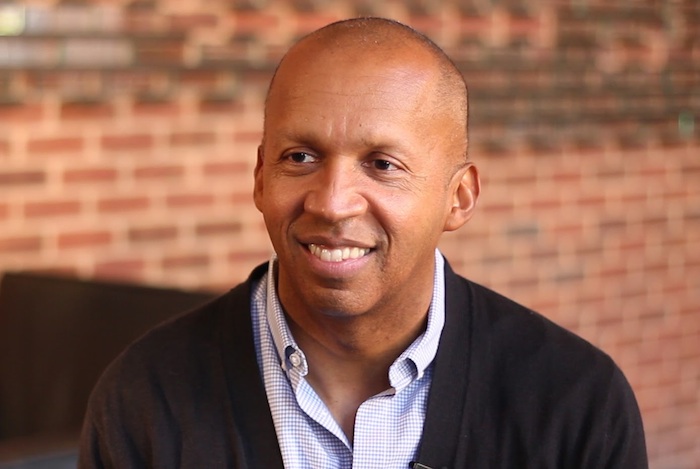Questions from the kids: our first school presentation of 2016
January 13, 2016 • 22 Comments • Posted in blindness, Braille, careers/jobs for people who are blind, questions kids ask, Seeing Eye dogs, technology for people who are blind, Uncategorized, visiting schoolsMy Seeing Eye dog Whitney and I started our new year of elementary school visits in a big way: we took a commuter train to Elmhurst (The Chicago suburb where I grew up) and gave a presentation to 250 kindergartners, first-graders, and second-graders. All. At. Once.
Whitney usually leads me to the train station in downtown Chicago on her own, but when my gem of a husband, Mike Knezovich, said he’d accompany us yesterday morning, I had five reasons to swallow my pride and accept his generous offer.
- Freezing temperatures — if Whitney and I found ourselves lost or turned around for just a few minutes, we might have ended up with frostbite!
- Snowy slippery sidewalks
- Salt (Mike can spot it on the roads and help us avoid those areas so it doesn’t end up in Whit’s paws)
- The train we needed to catch left at 7:40 a.m., which meant we’d be approaching the train station precisely when commuters were getting off trains and rushing to work
- And oh, yeah. I still have a cast on my broken left hand.
My sister Cheryl lives in Elmhurst. She greeted Whitney and me with hot coffee at the train station there, brought an extra-large-sized pair of mittens in the car to fit over my cast, drove us to Lincoln Elementary School, took pictures at the assembly, and then drove us all the way back to my doorstep in Chicago afterwards. Cheryl has always had a way of boosting my confidence, and we have fun whenever we’re together. I grew up the youngest of seven children. Cheryl is fourth in line, and this explanation of middle child syndrome describes her perfectly:
Many times they go in the opposite direction of their oldest sibling to carve out their own place of achievement and relish in the satisfaction of being capable of doing it on their own. They are sensitive to injustices and much less self-centered than their siblings (first born and last born), which allows them to maintain successful relationships. They are put in the position to learn social skills that are extremely useful, not only within their household, but within their social community.
The kids at Lincoln School were sweet, polite, and very curious. The Q & A part of the presentation was entertaining, as always. A sampling of their questions:
- What does your dog like to chase?
- How can you tie your shoes if you can’t see them?
- How long did it take you to learn to read and write Braille??
- How do you write if you can’t see?
- Do you shop by yourself?
- Can you write cursive?
- Does Whitney ever slip on the ice?
- Does your dog keep you safe from other things?
- Do you always have to say your dogs name before you tell her what to do?
For that last question, I picked up Whitney’s harness and told the kids that when you’re training at the Seeing Eye school they teach you to always say your dog’s name before giving them a command. “If I just say the word ‘right’ like I just did there, Whitney doesn’t even notice, but if I say, ‘Whitney, right’…”. I had to stop talking right there, mid-sentence. Whitney had immediately flipped right and was guiding us toward the hallway! “I guess the Seeing Eye knows what they’re doing,” I said with a laugh. The kids laughed right along. Whitney was a big hit.
The most thoughtful question yesterday was this one: “What is your biggest challenge of the day?” My days have been particularly challenging lately with this cast on my hand, but Mike and Cheryl made my day yesterday far less challenging than it would have been otherwise. Huge thanks to them both, and also to all my other friends and family who have boosted my spirits, many of them by taking me for walks while the cast was preventing me from grasping Whitney’s harness.
Broken hand update: my friend Colleen drove me to a medical appointment Monday and helped me convince the hand experts to shorten the cast a bit to expose the tips of my fingers. It’s a ton easier to hold the harness now. Whitney and I take a train to another suburban school tomorrow morning, and if the weather warms up enough by then to melt some of the snow and ice, we may be able to get to the train station on our own. I have my Fingers crossed — the ones in my right hand, at least.





